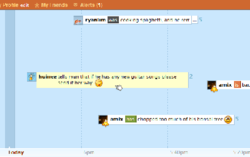Plurk: Difference between revisions
Chininazu12 (talk | contribs) No edit summary |
m →History: fixed malformed link |
||
| Line 27: | Line 27: | ||
* [[portmanteau]] of 'play' and 'work' |
* [[portmanteau]] of 'play' and 'work' |
||
* [[acronym]] of '''p'''eace, '''l'''ove, '''u'''nity, '''r'''espect, and '''k'''arma |
* [[acronym]] of '''p'''eace, '''l'''ove, '''u'''nity, '''r'''espect, and '''k'''arma |
||
* [[verb]] [[neologism]], similar to how [[Google]] was eventually used as a [[Google (verb)|verb] |
* [[verb]] [[neologism]], similar to how [[Google]] was eventually used as a [[Google (verb)|verb]] |
||
==Features and technology== |
==Features and technology== |
||
Revision as of 00:40, 8 August 2010
 | |
 Screenshot of a Plurk timeline | |
Type of site | Micro-blogging |
|---|---|
| Available in | Multilingual |
| Owner | Plurk, Inc. |
| Created by | The A-team[1] |
| URL | Plurk.com |
| Commercial | Yes |
| Registration | Required |
Plurk is a free social networking and micro-blogging service that allows users to send updates (otherwise known as plurks) through short messages or links, which can be up to 140 text characters in length.
Updates are then shown on the user's home page using a timeline which lists all the updates received in chronological order, and delivered to other users who have signed up to receive them. Users can respond to other users' updates from their timeline through the Plurk.com website, by instant messaging, or by text messaging.
Plurk is very popular in Taiwan, Philippines, Indonesia and the United States. According to Alexa, as of February 11, 2010[update], 34.4% of Plurk's traffic comes from Taiwan, and about 30% of Plurk's traffic comes from Southeast Asia.[3] Plurk is also ranked 24th in Taiwan and 1,062nd worldwide.[3]
History
Plurk was developed by and envisioned as a communication medium meant to form a balance between blogs and social networks, and between e-mail messaging and instant messaging. After months of development, Plurk was launched on May 2008.[4]
The etymology of the name was explained by the developers as such:[5]
- abbreviation of 'people' and 'lurk'
- portmanteau of 'play' and 'work'
- acronym of peace, love, unity, respect, and karma
- verb neologism, similar to how Google was eventually used as a verb
Features and technology
Plurk's interface shows updates in horizontal form through a scrollable timeline written in JavaScript and updated through AJAX. Users can post new messages with optional 'qualifiers', which are one-word verbs used to represent a thought (e.g. "feels", "thinks", "loves", etc.). There are also advanced features such as sending updates only to a subset of your friends, posting updates on events earlier in the day, and sharing images, videos, and other media.[6] Plurks can also be "liked", as in other social sites.
Plurk also supports group conversations between friends and allows usage of emoticons together with the usual text micro-blogging.[7]
The Plurk.com developers released public access to API on December 4, 2009 [8]
Due to messages being sent between users in near-realtime, many users use Plurk as an alternative to chat.
Availability in other languages
To help translate their base list of qualifiers/verbs into a number of languages, Plurk hosts its own translation website where users can submit translations of the Plurk user interface in their own local language.[9] As of July 2008, Plurk is translated into over twenty languages.
Reception
Plurk has often been considered to be a rival to Twitter, an earlier micro-blogging service.[10][11]
In June 2008, Plurk received online attention when it was featured by Leo Laporte and Amber MacArthur on their net@night show in the TWiT.tv podcast network.[12][13]
Controversies
MSN Juku controversy
Taiwan President assassination controversy
On March 20, 2010, Taiwan police investigated an Internet threat posted on plurk.com that called for the assassination of the President of Republic of China (Taiwan), Ma Ying-jeou.[14]
References
- ^ Plurk.com. "The A-Team". Plurk Inc. Retrieved 2008-07-24.
- ^ Amir Salihefendic (2008-05-12). "Plurk.com opens up". Retrieved 2008-07-24.
- ^ a b plurk.com - Site Info from Alexa. Retrieved on February 11, 2010.
- ^ akan (2008-05-20). "das leben der anderen - a window into the lives of others". Plurk Inc. Retrieved 2008-07-23.
- ^ akan (2008-06-02). "'Plurk'? An etymological deconstruction of the word you love to hate". Plurk Inc. Retrieved 2008-07-23.
- ^ Plurk.com. "FAQ". Plurk, Inc. Retrieved 2008-07-23.
- ^ Prashant Sharma. "Why Plurking is more fun than tweeting". TechPluto. Retrieved 2008-09-20.
- ^ alvin (2009-12-04). "Plurk API Service". Plurk.com.
- ^ akan (2008-06-28). "Introducing the Plurk Collaborative Translation Project - Help Us Bring Plurk to your Language". Plurk Inc. Retrieved 2008-07-23.
- ^ Michael Muchmore (2008-06-23). "Plurk.com - Full Review - Reviews by PC Magazine". Ziff Davis Publishing Holdings Inc. Retrieved 2008-07-23.
- ^ Stii Pretorius (2008-06-03). "Plurk, the new Twitter?". Mail & Guardian Online. Retrieved 2008-07-23.
- ^ Amber MacArthur and Leo Laporte (2008-06-04). "net@night 55: Tiffany Roll". TwiT.tv. Retrieved 2008-07-24.
- ^ Rafe Needleman (2008-06-02). "Plurk: Like Twitter, in good and bad ways". CNET Networks, Inc. Retrieved 2008-07-23.
An influx of users over the weekend (which is being blamed on or credited to Leo Laporte) has apparently overloaded the system, and occasionally users may find elements of it not working.
- ^ "Plurk User Calls for Assassination of Taiwan President". taipeitimes.com. 2009-03-21.
